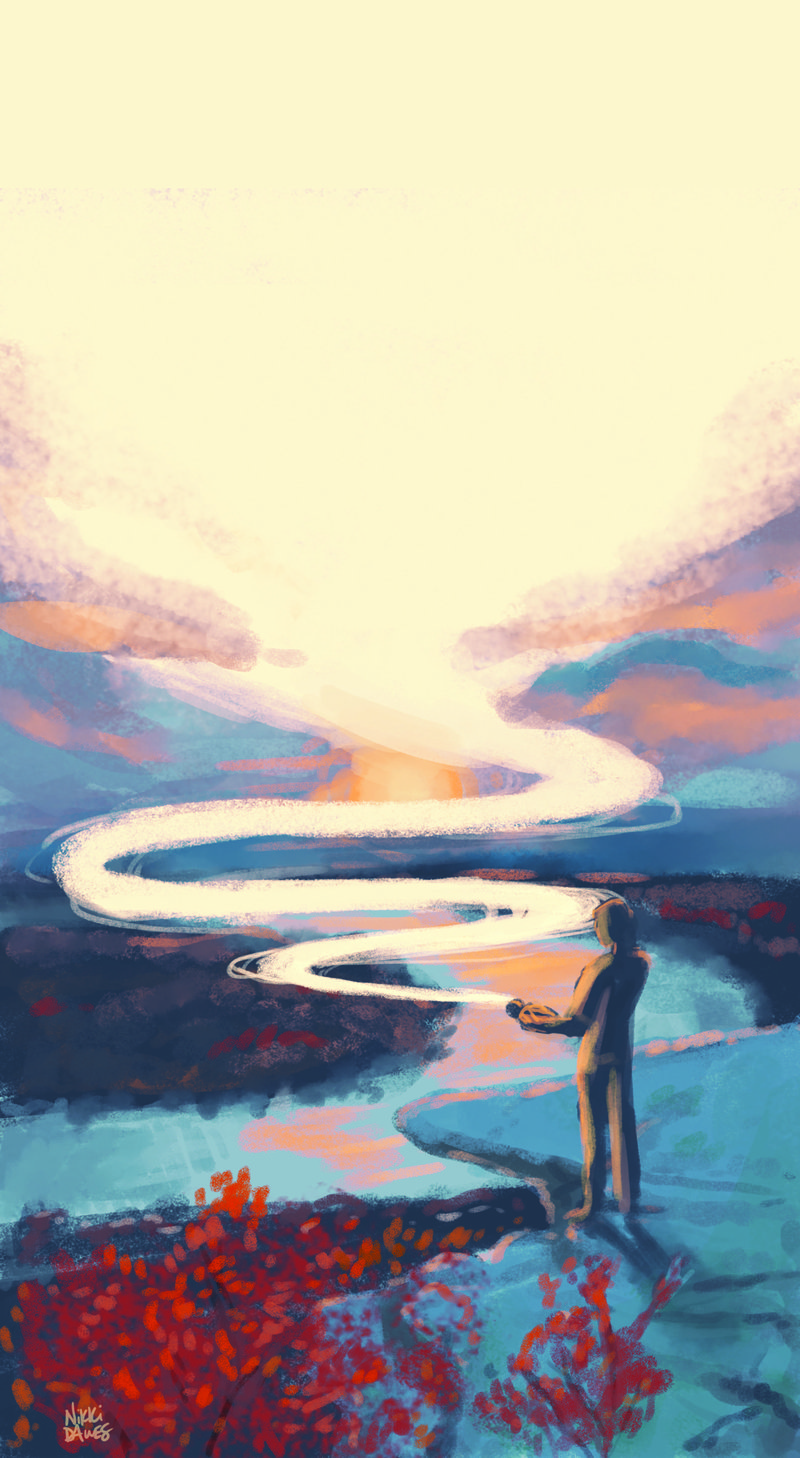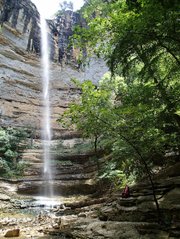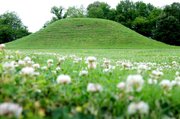Vacation destinations as a final resting place?
At first thought, that seems odd. But cremation is no longer unusual; the Cremation Association of North America estimates 44.42 percent of funerals in 2015 involved cremation. And for those who are passionate about the time they've spent in the great outdoors, having their ashes scattered around their favorite places seems a most natural choice.
"We're outdoorsy people and would certainly consider doing something like this," says Dana Steward of Sherwood. A 73-year-old retired teacher and writer, she and husband Bill have been active for decades in the Ozark Society and have fond memories of parks and wild places around the nation.
"I don't plan to have a burial with a casket," says Steward, who edited A Rough Sort of Beauty: Reflections on the Natural Heritage of Arkansas, a collection of history, memoir, poetry and fiction addressing what it means to have a sense of place.
She plans to be cremated, have a small portion of her ashes buried in her family's plot and then have the rest scattered. "The location of that would be private for me," she says of the outdoor places she's considering.
Her legal options are broad, including most (but not all) of Arkansas' state parks and most national parks as well as other sites overseen by the National Park Service.
The National Parks' terms are outlined in Title 36, Code of Federal Regulations, Section 2.62 (b). In between a section about residing on federal land being prohibited and another section addressing boating and water use is one titled "Memorialization."
Section 2.62 (b) explains that erecting monuments, memorials, tablets, structures or other commemorative installations in a park area without the authorization of the director is prohibited and that the scattering of human ashes from cremation is prohibited -- except when those doing so apply for a permit and abide by the terms and conditions of it or do so in designated areas according to conditions which may be established by the superintendent.
Apart from the regular fees charged for entering the national parks, there are usually no extra fees for scattering the ashes of loved ones, although especially large gatherings could require a special-use permit.
The National Park Service routinely grants permission for the scattering of ashes and so does the Bureau of Land Management. But each site, in addition to the National Park Service's basic guidelines, has the option of also creating its own rules specific to its site. These can be found in the park's superintendent's compendium.
Some terms and conditions seem to be standard across the board -- such as scattering the ashes in less populated areas; avoiding areas such as roads, trails, campgrounds and picnic areas; leaving nothing behind except the ashes (which should be scattered and not be buried, whether in a container or gathered together); and scattering the ashes in a quiet, low-key manner without music or the releasing of doves, butterflies or balloons.
Tricia Horn, management specialist with Hot Springs National Park, says that park has requests to scatter ashes fairly often -- at least six or seven each year.
"A lot of them have been locals who lived in Hot Springs," she says.
But those scattering ashes are not allowed to do so along the heavily populated promenade or in the bathhouses.
"We have special places designated for doing this -- West Mountain, Hot Springs Mountain and toward Goat Rock Trail are where we suggest -- it's wooded, less populated, and there are overlooks that are higher up."
This park requires those wishing to scatter ashes to fill out a general application for a special-use permit.
"We just like to know when they are there in the park and what they're doing," Horn says. "Usually when someone calls and says they'd like to do this, we have them send a letter with the details, and then we explain the guidelines we'd like them to follow."
Like the other National Park Service sites, Hot Springs wants those scattering ashes to avoid bodies of water and highly populated areas. And park officials want the event to be a quiet affair. No markers or tributes are to be erected either.
For those wishing to leave a tangible tribute behind, park officials encourage planting a tree instead.
"We have a program where the person's loved ones can buy a memorial tree," Horn says. "They must buy the tree and get it here, and we will choose the place it will be planted."
At the Hot Springs park, officials suggest certain types of trees.
"Dogwoods mainly," Horn says. "Because they bloom really nicely."
NATIVE REMAINS
Ed Wood, superintendent at Arkansas Post National Memorial in Gillett, says he is unaware of any such requests having been made at his site.
"We haven't had any requests from anyone wanting to do this, so we haven't had to face this particular issue yet," he says, adding that no additional guidelines or rules have been drafted for his site.
Lisa Frost, superintendent at the Fort Smith National Historic Site since 2013, says she has not had any requests during her tenure.
If and when she does, she says, she will refer to the National Park Service's management policies guidelines, which were last revised in 2006. She adds that the Fort Smith historic site has not created any local guidelines.
"If I were to receive such a request, I would also have to take into consideration any indigenous people or any sacred sites that might be affected by the scattering of remains," Frost says. "With the Native Americans here in Fort Smith, this is certainly something to take into consideration."
MEMORIAL POLLUTION?
Those wishing to scatter cremated remains in a national park need to steer clear of doing so in or near bodies of water.
Caven Clark, public information officer with the Buffalo National River, says the scattering of ashes within that property is allowed without having to apply for a permit -- as long as those doing so abide by the national site's guidelines. They are found on its website (nps.gov/buff) under "Superintendent's Compendium," updated in March 2015.
The Buffalo National River's compendium states that no permit is needed if the following terms and conditions are followed:
"The remains must have been cremated and pulverized, the scattering of remains on the ground is to be done at least 100 yards from any trail, road, developed facility or body of water; any scattering from the air must be performed at a minimum altitude of 2,000 feet above the ground, and no scattering of remains from the air is allowed over developed areas, facilities or bodies of water."
"I know that people do like to have the ashes scattered in water, though," Clark says. "In the film Buffalo Flows, one lady interviewed says she put her late husband's ashes in the river. When we saw that we thought, 'Uh-oh,' because that's not allowed.
"We didn't rush out and arrest her," Clark says, but adds, "Those who don't follow the guidelines are subject to being fined."
His park's compendium also notes that those doing the scattering should not scatter ashes over any developed areas including the river, waterfall, campground, road or trail; should not exclude other park visitors from any area; and should not move any rocks, vegetation or other natural resources.
The compendium also bans bringing "any potted plants, dried flower arrangements or any plant with seeds, as these may introduce non-native or invasive species."
He says most of those who scatter ashes in the park he oversees follow the guidelines and don't apply for permits.
"It's gotten to be extremely uncommon," he says of those who apply for a permit. "I can't think of anyone who has done so since I've been here, and I've been here for 12 years."
CLINTON'S OLD BACKYARD
So far, no one has asked for permission to spread ashes at the President William Jefferson Clinton Birthplace Home, a national historic site in Hope.
"I know of other parks that have those requests but so far, we haven't," says Tarona Armstrong, superintendent. Because there have been no requests, there aren't written rules. "But if we had a request, I am sure we would handle it with the respect and dignity it deserves," she says.
Kevin Eades, the superintendent at Pea Ridge National Military Park, says in the 10 months he has held his position, no one has asked to scatter ashes.
Those wishing to do so must apply for a permit, and they must have their permit with them when they scatter the ashes.
They are not permitted to scatter any ashes within areas of high archaeological value, such as a battlefield, and they must stay at least 300 feet away from any buildings or historic sites, including historic structures and cemeteries.
"The ashes can't be buried, in a container or even if they're not in a container," Eades says, to protect anything in the ground which may be of archaeological value.
To date, no one has requested to scatter loved ones' ashes at Central High School in Little Rock, says Robin White, the park's superintendent. As a result, the park has not added any local guidelines to the National Park Service's standard ones.
STATE PARKS
As for Arkansas state parks, they follow the same basic guidelines as the national ones, with scattering of ashes not allowed in heavily populated areas or in any of the parks that have archaeological importance, says Grady Spann, director of the Arkansas Department of Parks and Tourism's Arkansas State Parks division since January.
His predecessor, Greg Butts, who retired at the end of 2015 after 25 years as the state parks director, told him he would get about a dozen requests to scatter ashes each year.
"These types of requests are decided on a case-by-case basis," Spann says. "Whether or not the requests are approved depends upon what type of a park it is.
"Places like Toltec Mounds, which has Native American Indian mounds, and Prairie Grove, which is a battlefield, would be off limits."
"It's not something we do very often," Spann says of receiving and granting such requests, adding that those wishing to scatter cremains should contact his office directly at (501) 682-7743.
ActiveStyle on 04/11/2016




